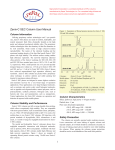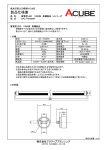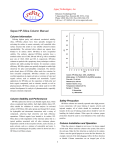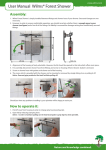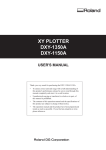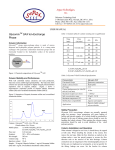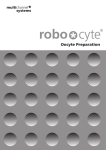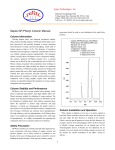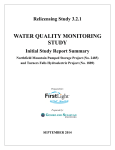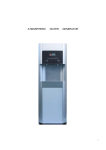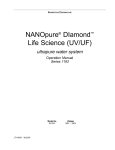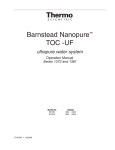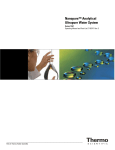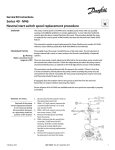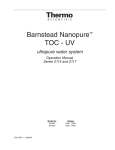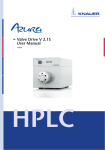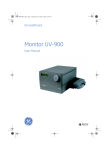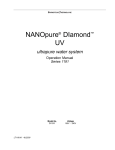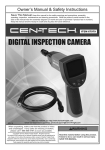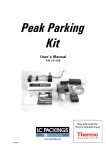Download SRT-C SEC Column User Manual - Sigma
Transcript
Sepax Technologies, Inc. Sigma-Aldrich Corporation is a worldwide distributor of HPLC columns manufactured by Sepax Technologies, Inc. For a complete listing of these and other Sepax columns, please consult www.sigmaaldrich.com/sepax . Delaware Technology Park 5-100 Innovation Way, Newark, DE 19711, USA Phone: (302) 366-1101; Fax: (302) 366-1151 Toll Free: 1-877-SEPAX-US; www.sepax-tech.com Figure 1. Separation of a protein mixture by SRT-C 300 column. SRT-C SEC Column User Manual Column Information 3 Utilizing proprietary surface technologies and 5 Pm particle size, SRT-C SEC phases are made of uniform, hydrophilic, and neutral nanometer thick films chemically bonded on the high purity and enhanced mechanical stability silica. The proprietary surface technologies allow the chemistry of thin film formation to be well controlled, which results in high column-to-column reproducibility. The nature of the chemical bonding and the maximum bonding density of the thin film benefit SRT-C SEC phases with high stability. The uniform surface coating enables high efficiency separation. The narrowly dispersed, spherical silica particles of the SRT-C 100, 150, 300, 500, 1000 and 2000 packings have nominal pore sizes at 100, 150, 300, 500, 1000 and 2000 Å, respectively. Their specially designed large pore volume enables high separation capacity, leading to high separation resolution. SRT-C SEC columns are packed with a proprietary slurry technique to achieve uniform and stable packing bed density for maximum column efficiency. SRT-C phases are designed to ensure high resolution and maximum recovery for a very broad range of separation applications. These applications cover large biological molecules, such as proteins and nucleic acids; small biological molecules, such as peptides and oligonucleotides; natural polymers, such as polysaccharides; synthetic polymers; biological cells, such as bacteria and virus; and nanomaterials, such as nanoparticles. Typical applications for SRT-C SEC columns are separation and detection in aqueous buffer mobile phases. 1 4 2 6 5 0.0 1.0 2.0 3.0 4.0 5.0 6.0 7.0 8.0 Min 9.0 10.0 11.0 12.0 13.0 14.0 15.0 Column: SRT-C 300 (7.8x300 mm, 5 m) Mobile phase: 150 mM PBS, pH 7 Flow rate: 1.0 mL/min Temperature: ambient (~23° C) Detection: UV 214nm Injection: 10 L Sample: 1) Thyroglobulin, 670kD; 2) J-Globulin, 158 kD; 3) Ovalbumin, 44kD; 4) Myoglobin, 17.6 kD; 5) Poly-DL-alanine (1-5 kD); 6) Uracil, 120D. Column Characteristics Silica: Spherical, high purity (<10 ppm metals) Particle size: 5 Pm Pore sizes for protein separation: 100 Å, MW range 100 ~ 100,000 150 Å, MW range 500 ~ 150,000 300 Å, MW range 5,000 ~ 1,250,000 500 Å, MW range 15,000 ~ 5,000,000 1000 Å, MW range 50,000 ~ 7,500,000 2000 Å, MW range >10,000,000 Column Stability and Performance SRT-C SEC columns use full coverage bonded silica packing, which allows exceptionally high stability. They are compatible with most aqueous buffers, such as ammonium acetate, phosphate, tris, etc. When 150 mM phosphate buffer at pH 7.0 is used as the mobile phase to run SRT-C SEC columns, 300 injections with protein standards of thyroglobulin, BSA, ribonuclease A and uracil, or 1 month of usage has negligible deterioration for SRT-C SEC columns. The neutral and hydrophilic SRT-C stationary phases have negligible nonspecific interactions with biological molecules, such as proteins, DNA, RNA and peptides. Combined with their high capacity, SRT-C SEC columns enable high efficiency and high recovery separations. Figure 1 shows an example of the separation of a protein mixture of thyroglobulin, J-Globulin, ovalbumin, myoglobin, poly-DL-alanine and uracil using 7.8x300 mm SRT-C 300 column. Safety Precaution The columns are normally operated under moderate pressure. Loose connections will cause leaking of organic solvents and injected samples, all of which should be considered as hazards. In the case of leaking, proper gloves should be worn while handling the columns. When opening the columns, proper protections should be used to avoid inhalation of the small silica particles. Column Installation and Operation The column should always be capped at both ends when it is not in use. When installing the column to the system, first remove the end caps. Unless a user has special purpose to reverse the flow direction, for example, removal of the inlet blockage, follow the flow direction as marked on the column. Column connections are an integral part of the chromatographic process. If ferrules are over tightened, not set properly, or are not specific for the fitting, 1 30oC. Continuous use of the column at a higher temperature (>80oC) can damage the column, especially under high pH (>8). Flow rate Range Normal operating flow rate is 0.1 0.4 and 0.1 - 1.25 mL/min for 4.6 mm and 7.8 mm I.D. columns, respectively. Storage When the column is not in use for an extended time, the column should be stored in 150 mM sodium phosphate buffer, pH 7.0. Each column is shipped with two removable end plugs. To prevent drying of the column bed, seal both ends of the column with the end plugs provided. Cleaning From time to time, some samples could get adsorbed onto the inlet frit or the packing material. When the adsorption accumulates to a certain level, it is usually indicated by an increase in backpressure and a broader peak. When this occurs, it is time to clean your column. The general procedure for column cleaning is as follows: 1. Disconnect the column from the detector. 2. Clean your column in the reverse flow direction. 3. Run the column at less than 50% of the maximum recommended flow rate. Monitor the backpressure. If you see the pressure is much higher than the normal operating conditions, you need to lower the flow rate or change the washing buffer as the cleaning solutions may be of different viscosities. 4. Typically, 10-15 column volumes of cleaning solution are sufficient. Rinse well with 3-5 column volume of Nanopure water between each solution. Cleaning solutions Low pH salt solutions help remove basic proteins. Organics are useful when removing hydrophobic proteins. Chaotropic agents help remove strongly adsorbed materials (e.g., via hydrogen bonding). Only use chaotropic agents when neutral salts or organics have not improved resolution. Two cleaning solutions are recommended for general cleaning: 1. Concentrated neutral salt (e.g., 0.5 M Na2SO4) at low pH (e.g., pH 3.0). 2. Water soluble organic (MeOH, ACN, EtOH, 10%-20%) in aqueous buffer (e.g., 50 mM phosphate, pH 7.0). leakage can occur. Set the ferrules for column installation to the HPLC system as follows: (a) Place the male nut and ferrule, in order, onto a 1/16" outer diameter piece of tubing. Be certain that the wider end of the ferrule is against the nut. (b) Press tubing firmly into the column end fitting. Slide the nut and ferrule forward, engage the threads, and fingertighten the nut. (c) Repeat this coupling procedure for the other end of the column. Samples and Mobile Phases To avoid clogging the column, all samples and solvents should be filtered through 0.45 Pm or 0.2 Pm filters before use. SRT-C SEC columns are compatible with an aqueous mobile phase or a mixture of organic solvent and water, such as methanol or acetonitrile and water. Always degas the mobile phase. A simple way for degassing is to sonicate it for 5 minutes under water pumped vacuum. Column Care Shipping Solvent New columns are shipped in 150 mM sodium phosphate buffer, pH 7.0. During stocking and shipping, the silica packing may become dried out. It is recommended that 10-20 column volumes of 50 mM sodium phosphate buffer at pH 7.0 be purged to activate the column. Flush the column with your mobile phase while gradually increasing the flow rate from 0.1 mL/min to your operating condition, until the baseline is stable. If the column backpressure and baseline fluctuate, this might be due to air bubbles trapped inside the column. Flush the column with higher flow rate for 2-5 minutes, for example 0.5 mL/min and 1.25 mL/min for 4.6x300 mm and 7.8x300 mm columns, respectively. pH For optimum performance and operation during the longest lifetime keep pH between 2 and 8.5. Pressure Even though the columns can operate at a pressure up to 3,500 psi, the normal operating pressure is usually under 2,000 psi. Continuous use at a high pressure may eventually damage the column. Since the pressure is generated by the flow rate, the maximum flow rate is limited by the backpressure. It is expected that the backpressure might gradually increase with its service. A sudden increase in backpressure suggests that the column inlet frit might be blocked. In this case it is recommended that the column be flushed with reverse flow in an appropriate solvent. Solvent compatibility Columns are compatible with aqueous buffers, such as phosphate, acetate, Tris, etc; and water miscible organic solvents, such as MeOH, ethanol, isopropanol, acetonitrile, THF, etc. When switching from an aqueous buffer to an organic solvent, the column should be washed with nanopure water for at least 30-column volume, then ethanol for 20-column volume. When switching from an organic solvent to an aqueous buffer, the column should be washed with ethanol for at least 30column volume, then nanopure water for 20-column volume, and finally 20-column volume aqueous buffer. After washing, it is recommended that the column be stored in the aqueous buffer for 48 hours to get well equilibrated for satisfactory performance. Temperature The maximum operating temperature is 80oC. The optimum operating temperature for the longest lifetime is 10 - Column Protection In addition to filtering the sample and the mobile phase, the best way to protect the separation column is to install a guard column or a pre-column filter in front of it. In most cases a precolumn filter helps to remove the residual particulates that are in the sample, the mobile phase, or leached from the HPLC system, such as pump and injector seals. However, a guard column is highly recommended because it is more effective in trapping highly adsorptive sample components and residual particulates in the sample, the mobile phase or from the HPLC system. 2 T-IM-SRT-C


